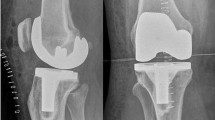Abstract
Introduction
Well leg compartment syndrome is a rare postoperative condition that occurs as a result of non-traumatic ischemic insult. It has similar pathophysiology to compartment syndrome; however, no definitive etiology is identified. Several risk factors such as patient position, leg position, young age, and high BMI for the development of this condition are considered.
Case report
A 30 years old male smoker and overweight, underwent mandibular and maxillary osteotomies in reverse Trendelenburg position. He developed a WLCS post-operative and treated with fasciotomy.
Conclusion
Increased Awareness of this rare occurrence and predisposition aids in understanding and prompt management. This article provides a rare case that has occurred in reverse Trendelenburg position with less obvious risk factors than typically reported in the literature
Similar content being viewed by others
References
Martin JT (1992) Compartment syndromes: concepts and perspectives for the anesthesiologist. Anesth Analg 75:275–283
Beraldo S, Dodds SR (2006) Lower limb acute compartment syndrome after colorectal surgery in prolonged lithotomy position. Dis Colon Rectum 49:1772–1780. https://doi.org/10.1007/s10350-006-0712-1
Olson SA, Glasgow RR (2005) Acute compartment syndrome in lower extremity musculoskeletal trauma. J Am Acad Orthop Surg 13:436–444
Mubarak SJ, Hargens AR (1983) Acute compartment syndromes. Surg Clin N Am 63:539–565. https://doi.org/10.1016/S0039-6109(16)43030-6
Heppenstall B, Tan V (1999) Well-leg compartment syndrome. Lancet 354:970. https://doi.org/10.1016/S0140-6736(98)00409-7
Cohen SA, Hurt WG (2001) Compartment syndrome associated with lithotomy position and intermittent compression stockings. Obstet Gynecol 97:832–833. https://doi.org/10.1016/S0029-7844(00)01141-8
Raza A, Byrne D, Townell N (2004) Lower limb (well leg) compartment syndrome after urological pelvic surgery. J Urol 171:5–11. https://doi.org/10.1097/01.ju.0000098654.13746.c4
Leff RG, Shapiro SR (1979) Lower extremity complications of the lithotomy position: prevention and management. J Urol 122:138–139. https://doi.org/10.1016/S0022-5347(17)56290-4
O’Shea E, Power K (2008) Well leg compartment syndrome following prolonged surgery in the supine position. Can J Anaesthesia = Journal canadien d’anesthésie 55:794–795. https://doi.org/10.1007/BF03016360
Halliwill JR, Hewitt SA, Joyner MJ, Warner MA (1998) Effect of various lithotomy positions on lower extremities blood pressure. Anesthesiology 89:1373–1376
Chase J, Harford F, Pinzur MS, Zussman M (2000) Intraoperative lower extremity compartment pressures in lithotomy-positioned patients. Dis Colon Rectum 43:678–680. https://doi.org/10.1007/BF02235587
Warner MA, Martin JT, Schroeder DR, Offord KP, Chute CG (1994) Lower-extremity motor neuropathy associated with surgery performed on patients in a lithotomy position. Anesthesiology 81:6–12. https://doi.org/10.1097/00000542-199407000-00004
Cascio BM, Buchowski JM, Frassica FJ (2004) Well-limb compartment syndrome after prolonged lateral decubitus positioning. A report of two cases. J Bone Joint Surg Am 86-A:2038–2040
Beadnell SW, Saunderson JR, Sorenson DC (1988) Compartment syndrome following oral and maxillofacial surgery. J Oral Maxillofac Surg 46:232–234. https://doi.org/10.1016/0278-2391(88)90089-4
Kavouni A, Ion L (2000) Bilateral well-leg compartment syndrome after supine position surgery. Ann Plast Surg 44:462–463
Strickland SM, Westrich GH (2000) Spontaneous compartment syndrome occurring postoperatively in 2 oral surgery patients. J Oral Maxillofac Surg 58:814–816. https://doi.org/10.1053/joms.2000.7280
Donmez A, Aral E, Arslan G et al (2002) Compartment syndrome: an unusual complication of donor hepatectomy. Transpl Int 485:28–31. https://doi.org/10.1007/s00147-002-0389-x
Malahias M, Ghorbanian S, Lemonas P (2012) Bilateral lower limb compartment syndrome: a potentially destructive complication of breast reduction. Ann R Coll Surg Engl 94:33–34. https://doi.org/10.1308/003588412X13171221589379
O’Connor D, Breslin D, Barry M (2010) Well-leg compartment syndrome following supine position surgery. Anaesth Intensive Care 38:595
Leroux C, Beliard C, Theolat M et al (1999) Syndrome postoperatoire des loges tibiales antero-externes : coresponsabilite de la table operatoire. Annales Françaises d’Anesthésie et de Réanimation 18:1061–1064. https://doi.org/10.1016/S0750-7658(00)87440-7
Lachmann EA, Rook JL, Tunkel R, Nagler W (1992) Complications associated with intermittent pneumatic compression. Arch Phys Med Rehabil 73:482–485
Chen AH, Frangos SG, Kilaru S, Sumpio BE (2001) Intermittent pneumatic compression devices—physiological mechanisms of action. Eur J Vasc Endovasc Surg 21:383–392. https://doi.org/10.1053/ejvs.2001.1348
Verdolin MH, Toth AS, Schroeder R (2000) Bilateral lower extremity compartment syndromes following prolonged surgery in the low lithotomy position with serial compression stockings. Anesthesiology 92:1189–1191. https://doi.org/10.1097/00000542-200004000-00038
Werbel GB, Shybut GT (1986) Acute compartment syndrome caused by a malfunctioning pneumatic-compression boot. A case report. J Bone Joint Surg Am 68:1445–1446
Barak M, Yoav L, Abu El-Naaj I (2015) Hypotensive anesthesia versus normotensive anesthesia during major maxillofacial surgery: a review of the literature. Sci World J 2015:480728. https://doi.org/10.1155/2015/480728
Precious DS, Splinter W, Bosco D (1996) Induced Hypotensive Anesthesia for Adolescent Orthogna thic Surgery Patients. J Oral Maxillofac Surg 54:680–683
Dolman RM, Bentley KC, Head TW, English M (2000) The effect of hypotensive anesthesia on blood loss and operative time during Le Fort I osteotomies. J Oral Maxillofac Surg 58:834–839. https://doi.org/10.1053/joms.2000.8194
Horgan AF, Geddes S, Finlay IG (1999) Lloyd-Davies position with Trendelenburg—a disaster waiting to happen? Dis Colon Rectum 42:916–919; discussion 919-20. https://doi.org/10.1007/BF02237102
Anema JG, Morey AF, Mcaninch JW et al (2000) Complications related to the high lithotomy position during urethral reconstruction. J Urol 164:360–363
Godeiro-Júnior CO, Oliveira ASB, Felício AC et al (2007) Peroneal nerve palsy due to compartment syndrome after facial plastic surgery. Arq Neuropsiquiatr 65:826–829
Author information
Authors and Affiliations
Corresponding author
Ethics declarations
Conflict of interest
The authors declare that they have no conflict of interest.
Ethical approval
The manuscript did not require ethical approval.
Additional information
Publisher’s note
Springer Nature remains neutral with regard to jurisdictional claims in published maps and institutional affiliations.
Rights and permissions
About this article
Cite this article
Alshakhas, M., Alatel, A. Well leg compartment syndrome postorthognathic surgery under hypotensive anesthesia and reverse Trendelenburg position: a case report and literature review. Oral Maxillofac Surg 25, 417–420 (2021). https://doi.org/10.1007/s10006-020-00936-6
Received:
Accepted:
Published:
Issue Date:
DOI: https://doi.org/10.1007/s10006-020-00936-6




